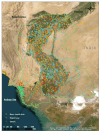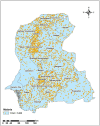Subnational malaria burden in Sindh, Pakistan: over a decade of evidence for tailored strategies
- PMID: 40830868
- PMCID: PMC12363049
- DOI: 10.1186/s12936-025-05505-4
Subnational malaria burden in Sindh, Pakistan: over a decade of evidence for tailored strategies
Abstract
Background: Accurate estimates of malaria burden are crucial for allocating resources and designing effective control strategies. However, global reports often underestimate the burden in low- and middle-income countries, especially beyond the African region. This study addresses this gap by providing a longitudinal time-series analysis of malaria burden and spatio-temporal distribution in Sindh province, Pakistan.
Methods: Monthly suspected malaria cases reported from 1088 primary healthcare facilities managed by the PPHI-Sindh across 23 districts of Sindh Province (excluding seven districts of Karachi), Pakistan, were analysed over a 13-year period (2012-2024). Malaria incidence was determined by dividing total malaria cases by each health facility's catchment area population. Population-weighted estimates of malaria cases were calculated to account for variations in population size across districts. Yearly time-trend (with 95% CI), seasonal variation by month (with 95% CI), and a treemap illustrating the distribution of malaria burden across districts in Sindh.
Results: An incidence of 92 per 1000 people per annum of suspected malaria cases was reported at primary public healthcare facilities. Pooled estimates of 16.7 million cases occurred during a 13-year period, about 1.28 million cases annually. Marked heterogeneity observed in malaria burden across districts. Malaria positivity rate was 12.3%. Six districts (Khairpur, Sanghar, Naushero Feroze, Badin, Mirpurkhas, and Larkana) carried over 53% burden of malaria in Sindh. A distinct seasonal pattern with peak coinciding with the wet season and post-monsoon period was observed. Since the 2022 floods in Sindh, the malaria incidence has doubled, and it is persisting in the province.
Conclusions: The study highlights the substantial malaria burden with wet seasons and post-monsoon peaks in Sindh and identified few high-burden districts. The impact of 2022 flood seems to have persisted to 2024 and onwards, which needs immediate attention. Identification of high-burden districts could help tailor malaria control strategies. Also, the underestimation by global reports emphasizes the need for country-level and subnational analyses for informed decision-making. By addressing these gaps and refining burden estimates, Pakistan can develop more targeted strategies towards malaria control.
Keywords: GIS; High-burden; Incidence; Malaria; Seasonality; Spatio-temporal distribution; Time-series.
© 2025. The Author(s).
Conflict of interest statement
Declarations. Ethics approval and consent to participate: Not applicable. No human interaction occurred for collection of data. Consent for publication: Not applicable. Competing interests: The authors declare no competing interests.
Figures







Similar articles
-
Prescription of Controlled Substances: Benefits and Risks.2025 Jul 6. In: StatPearls [Internet]. Treasure Island (FL): StatPearls Publishing; 2025 Jan–. 2025 Jul 6. In: StatPearls [Internet]. Treasure Island (FL): StatPearls Publishing; 2025 Jan–. PMID: 30726003 Free Books & Documents.
-
[Volume and health outcomes: evidence from systematic reviews and from evaluation of Italian hospital data].Epidemiol Prev. 2013 Mar-Jun;37(2-3 Suppl 2):1-100. Epidemiol Prev. 2013. PMID: 23851286 Italian.
-
Bayesian spatio-temporal modeling and prediction of malaria cases in Tanzania mainland (2016-2023): unveiling associations with climate and intervention factors.Int J Health Geogr. 2025 Aug 1;24(1):20. doi: 10.1186/s12942-025-00408-8. Int J Health Geogr. 2025. PMID: 40750887 Free PMC article.
-
Indoor residual spraying for preventing malaria.Cochrane Database Syst Rev. 2010 Apr 14;2010(4):CD006657. doi: 10.1002/14651858.CD006657.pub2. Cochrane Database Syst Rev. 2010. PMID: 20393950 Free PMC article.
-
Physical interventions to interrupt or reduce the spread of respiratory viruses.Cochrane Database Syst Rev. 2023 Jan 30;1(1):CD006207. doi: 10.1002/14651858.CD006207.pub6. Cochrane Database Syst Rev. 2023. PMID: 36715243 Free PMC article.
References
-
- WHO. Global malaria report 2023. Geneva: World Health Organization; 2023. https://www.who.int/teams/global-malaria-programme/reports/world-malaria...
-
- WHO. Global malaria report 2022. Geneva: World Health Organization; 2022. https://www.who.int/teams/global-malaria-programme/reports/world-malaria...
-
- Pakistan. 18th Amendment to the Constitution of Pakistan. Islamabad: Government of Pakistan; 2010.
-
- WHO. Global technical strategy for malaria 2016–2030 (2021 update). Geneva: World Health Organization; 2021.
MeSH terms
LinkOut - more resources
Full Text Sources
Medical
Miscellaneous

